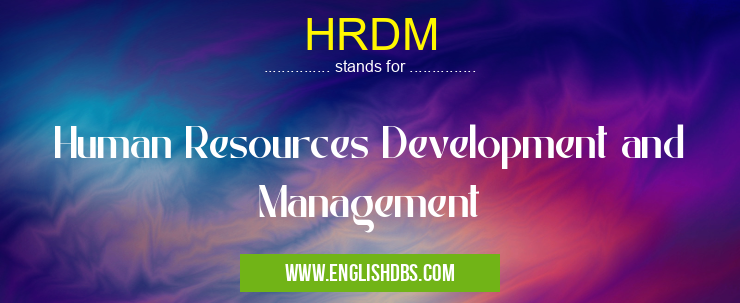What does HRDM mean in DEVELOPMENT
HRDM stands for Human Resources Development and Management. It encompasses the processes and strategies involved in managing and developing an organization's human capital. HRDM focuses on attracting, retaining, and developing talented employees to enhance organizational performance.

HRDM meaning in Development in Community
HRDM mostly used in an acronym Development in Category Community that means Human Resources Development and Management
Shorthand: HRDM,
Full Form: Human Resources Development and Management
For more information of "Human Resources Development and Management", see the section below.
» Community » Development
What is HRDM?
HRDM involves a wide range of activities, including:
- Talent Management: Identifying, attracting, and retaining top talent.
- Learning and Development: Providing employees with opportunities for growth and professional development.
- Performance Management: Setting performance goals, evaluating progress, and providing feedback.
- Compensation and Benefits: Designing and administering competitive compensation and benefits packages.
- Employee Relations: Maintaining positive employee-management relationships and addressing employee concerns.
Importance of HRDM
Effective HRDM is crucial for organizational success. It enables companies to:
- Improve Employee Engagement: Engaged employees are more productive and motivated.
- Enhance Performance: Well-trained and developed employees contribute to higher performance levels.
- Reduce Turnover: Investing in employee development helps retain valuable talent.
- Foster Innovation: A skilled and engaged workforce drives innovation and creativity.
- Meet Business Objectives: HRDM aligns human capital strategies with overall business goals.
Essential Questions and Answers on Human Resources Development and Management in "COMMUNITY»DEVELOPMENT"
What is Human Resources Development and Management (HRDM)?
HRDM encompasses the processes and strategies organizations use to enhance their employees' skills, knowledge, and capabilities to achieve organizational goals and individual growth.
What are the key functions of HRDM?
HRDM involves various functions, including recruitment and selection, training and development, performance management, succession planning, and compensation and benefits.
What are the benefits of effective HRDM?
Effective HRDM practices can lead to improved employee productivity, increased job satisfaction, reduced employee turnover, and a more engaged and motivated workforce.
How can organizations implement effective HRDM programs?
To implement effective HRDM programs, organizations should align HR strategies with business goals, conduct thorough needs assessments, provide customized training and development opportunities, and foster a culture of continuous learning.
What are the challenges in HRDM?
HRDM faces challenges such as rapidly changing technologies, globalization, demographic shifts, and increasing employee expectations. Organizations must adapt their HRDM strategies to address these challenges.
What is the role of technology in HRDM?
Technology plays a significant role in HRDM by automating processes, providing data insights, and facilitating virtual training and development programs.
How does HRDM contribute to organizational success?
Effective HRDM practices enable organizations to attract and retain top talent, develop a skilled and adaptable workforce, and create a positive and productive work environment that drives organizational success.
Final Words: HRDM plays a vital role in the success of any organization. By effectively managing and developing its human capital, companies can improve employee engagement, enhance performance, and ultimately achieve their business objectives. HRDM is an essential investment in the future of any organization that recognizes the value of its people.
HRDM also stands for: |
|
| All stands for HRDM |
